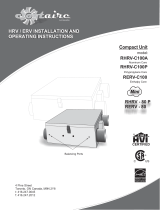Reversomatic RERV S500 is an energy recovery ventilator designed to provide fresh, filtered air to your home while exhausting stale air. It features an enthalpy core that transfers heat and moisture between the incoming and outgoing air streams, helping to maintain a comfortable indoor environment. The RERV S500 is ideal for homes with central heating and cooling systems, and can be installed in a variety of locations, including attics, basements, and crawl spaces.
Here are some of the key features and benefits of the Reversomatic RERV S500:
- Energy recovery: The enthalpy core helps to reduce energy consumption by transferring heat and moisture between the incoming and outgoing air streams. This can help to lower your heating and cooling costs.
Reversomatic RERV S500 is an energy recovery ventilator designed to provide fresh, filtered air to your home while exhausting stale air. It features an enthalpy core that transfers heat and moisture between the incoming and outgoing air streams, helping to maintain a comfortable indoor environment. The RERV S500 is ideal for homes with central heating and cooling systems, and can be installed in a variety of locations, including attics, basements, and crawl spaces.
Here are some of the key features and benefits of the Reversomatic RERV S500:
- Energy recovery: The enthalpy core helps to reduce energy consumption by transferring heat and moisture between the incoming and outgoing air streams. This can help to lower your heating and cooling costs.













-
 1
1
-
 2
2
-
 3
3
-
 4
4
-
 5
5
-
 6
6
-
 7
7
-
 8
8
-
 9
9
-
 10
10
-
 11
11
-
 12
12
-
 13
13
Reversomatic RERV S500 User manual
- Type
- User manual
- This manual is also suitable for
Reversomatic RERV S500 is an energy recovery ventilator designed to provide fresh, filtered air to your home while exhausting stale air. It features an enthalpy core that transfers heat and moisture between the incoming and outgoing air streams, helping to maintain a comfortable indoor environment. The RERV S500 is ideal for homes with central heating and cooling systems, and can be installed in a variety of locations, including attics, basements, and crawl spaces.
Here are some of the key features and benefits of the Reversomatic RERV S500:
- Energy recovery: The enthalpy core helps to reduce energy consumption by transferring heat and moisture between the incoming and outgoing air streams. This can help to lower your heating and cooling costs.
Ask a question and I''ll find the answer in the document
Finding information in a document is now easier with AI
Related papers
-
 Reversomatic RERV-S100 User manual
Reversomatic RERV-S100 User manual
-
 Reversomatic RHRV-S200A User manual
Reversomatic RHRV-S200A User manual
-
 Reversomatic RERV-D100ECM User manual
Reversomatic RERV-D100ECM User manual
-
 Reversomatic RERV-S200ES User manual
Reversomatic RERV-S200ES User manual
-
 Reversomatic RERV-D100 User manual
Reversomatic RERV-D100 User manual
-
 Reversomatic RHRV-C100PECM User manual
Reversomatic RHRV-C100PECM User manual
-
 Reversomatic RERV-D100 Installation And Operating Instructions Manual
Reversomatic RERV-D100 Installation And Operating Instructions Manual
-
 Reversomatic RHRV-80P User manual
Reversomatic RHRV-80P User manual
Other documents
-
Ortech SDF200-2 User manual
-
Oneida Air Systems DBD Installation guide
-
FIELD CONTROLS FC95HRV. User manual
-
 American Aldes Premium HRV300DDD Operation and Installation Manual
American Aldes Premium HRV300DDD Operation and Installation Manual
-
AGI Dust Collecting System Maintenance Manual
-
Amana HRV-150 User manual
-
Lifebreath METRO 120ERVD-ECM Installation guide
-
Aldes H/E150 Installation, Operation & Maintenance Manual
-
Fantech Platinum Stage User manual
-
Lifebreath 500DCS User manual





















